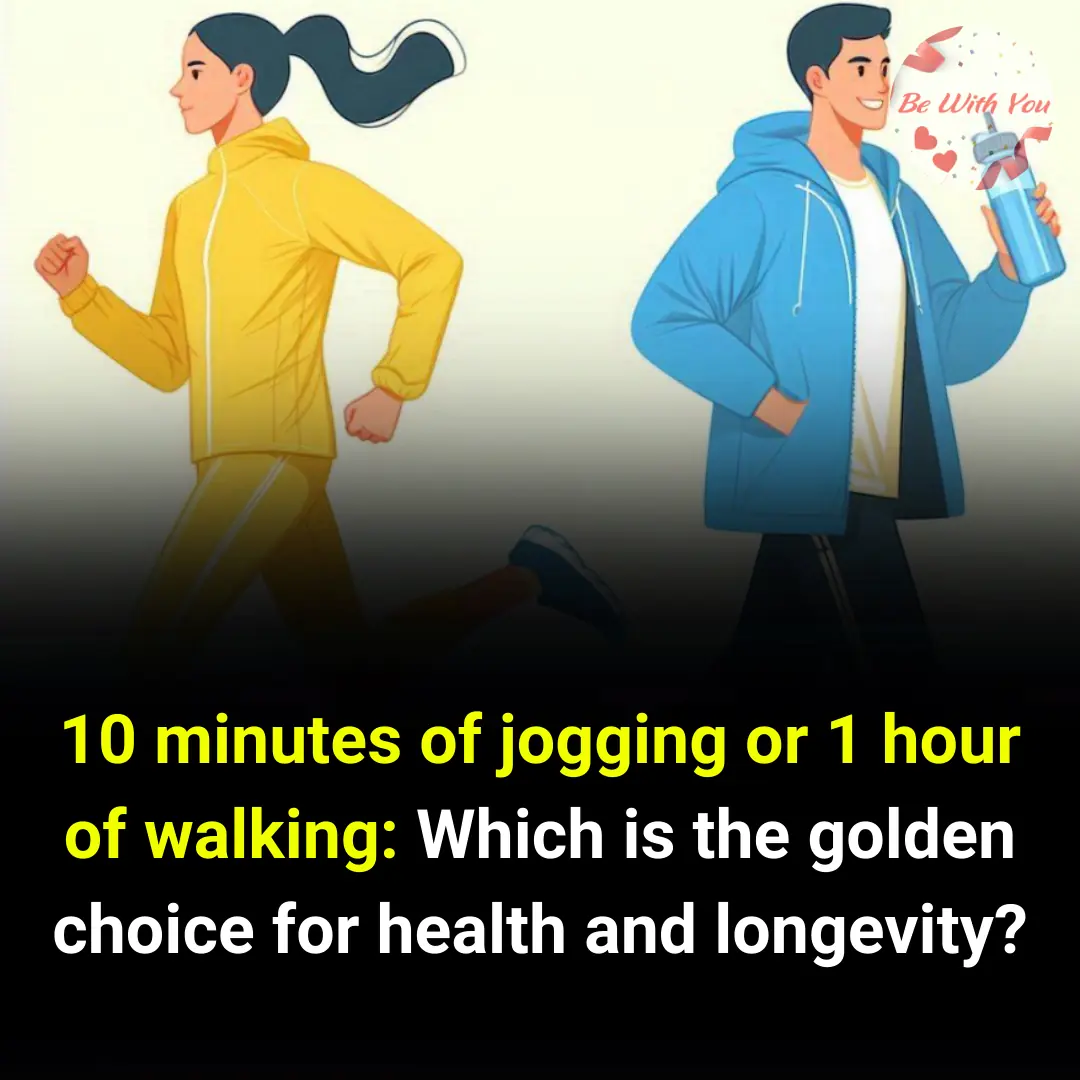
10 minutes of jogging or 1 hour of walking: Which is the golden choice for health and longevity?

Walking and jogging are two very effective forms of physical exercise for cardiovascular health, commonly known as cardio. Research shows that both types of exercise have the ability to support weight loss, maintain body weight, increase endurance and enhance the immune system. In addition, they also contribute to improving cardiovascular health and can prolong life. Regularly performing walking and jogging activities also helps prevent some mental illnesses such as depression and anxiety disorders, while making your mental life richer and more enjoyable.
Many people wonder whether, for those with busy schedules, running for 10 minutes at home is as effective as walking outdoors for 1 hour.
A study published in the Journal of the American College of Cardiology found that running, even at a slow pace for 5-10 minutes a day, can significantly reduce health risks and contribute to longevity. Additionally, a study from the Harvard School of Public Health found that spending just 10-15 minutes a day running can reduce the risk of many diseases, including the possibility of depression by up to 26%.
According to the Times Of India, jogging in place is a high-intensity form of exercise that can have a positive impact on health and fitness, especially compared to walking, which is considered moderate intensity. This can help increase calorie burn and improve metabolic health. For those looking to lose weight or improve cardiovascular fitness, the increased calorie burn from jogging in place can be of significant benefit. Therefore, busy people, especially office workers, can jog in place for 10 minutes to save time.
Master, Doctor Nguyen Thuy Song Ha, Department of Sports Medicine and Endoscopy, Orthopedic Trauma Center, also emphasized that running, regardless of form, is beneficial for health, helps burn calories, control weight, reduce the risk of chronic diseases and prolong life. However, the practitioner should choose between running on a treadmill or outdoors to improve health based on the subject and personal goals.
According to Dr. Ha, if you have a treadmill at home, you can exercise at any time, whether the weather is bad or you are in a state of social distancing. The treadmill allows you to adjust parameters such as speed, incline, time and calories burned. Moreover, running on a treadmill is safer, minimizing the risk of falls and injuries thanks to the flat surface and few obstacles. However, if you want to improve your mood and bone and joint health, running outdoors will bring more benefits.
Dr. Ha also emphasized that jogging is a high-intensity exercise, so you should warm up thoroughly before starting to increase blood flow, soften joints and stretch muscles. Choose suitable running shoes (you can choose a slightly larger size for more comfort) and breathable clothing. Don't forget to drink enough water before, during and after exercise. When you are near the end, you should gradually slow down and switch to walking to reduce your heart rate and stretch your muscles, helping your body gradually return to normal.
Walking 1 hour a day: Significant benefits for cardiovascular health
According to specialist doctor I Nguyen Huy Hoang of the Vietnam - Russia Hyperbaric Oxygen Center, Ministry of National Defense, walking is not only a recreational activity but also an effective method to improve health. In addition to strengthening the health of the heart and lungs, walking also helps reduce the risk of cardiovascular diseases, control blood pressure, reduce joint pain, strengthen bones and reduce excess fat in the body. This also helps prevent certain diseases, including cancer.
A report from Harvard Health says that if you spend 30 minutes to 1 hour walking every day, you can reduce your risk of heart disease by up to 30%. Studies have shown that this activity reduces the occurrence of heart disease risk factors, such as high blood pressure, high cholesterol, and high blood sugar.
In addition, walking also helps burn fat and improve the body's ability to use glucose. Continuous movement at high intensity for a long time can stabilize the heart rate, lower blood pressure, and increase the flexibility of the vascular wall.
When you spend 1 hour a day walking, the muscles will work continuously, which not only increases the amount of calories consumed during the exercise but also creates a maintenance effect, when the muscles need energy to recover and repair. As a result, the calorie burning process is enhanced, effectively supporting weight loss.
Walking for 1 hour every day also helps improve muscle flexibility and increase the endurance of the respiratory and circulatory systems. These benefits are not only good for overall health but also improve performance in weight control.
The amount of calories burned when walking depends on many factors, including body weight, speed of movement and activity level. In the average adult, the amount of calories burned can range from 300 to 400 calories in 1 hour of walking.
Combined with a reasonable diet, walking for 1 hour every day can become a key factor in a weight loss strategy and maintaining a healthy lifestyle.
Dr. Hoang also recommends that practitioners choose comfortable clothes and drink enough water before and after walking. Before starting, you should have a few minutes of gentle warm-up and gradually increase the speed. If you are walking on difficult terrain, be aware of potential hazards, such as cliffs or large waves near the ocean. If you feel unsafe walking alone, find a friend or family member to go with you.
To get the most health benefits, aim for 8,200 to 10,000 steps a day. Getting into the habit of walking regularly will help you maintain better health in the long run.
News in the same category


No Matter How Delicious, Avoid Overeating These Foods to Protect Your Liver

Two strange points of headache warn of brain tumor, don't ignore

5 Drinks That Damage the Liver Faster Than A.lco.ho.l

Limit Chicken and Beef in April, Prioritize These 3 Nutritious Meats

5 Foods That Are Considered "Parasite Havens" – Some of Which Are Very Popular

You’ll keep her/him satisfied all night long with this powerful mix...

Eating eggs with avocado for breakfast

You're looking for natural remedies

Boost Your Morning with a Game-Changing Coffee and Egg Combo

See a Doctor Immediately as You May Have Meningococcal Meningitis

Experts Advise Keeping These 3 Things in Mind When Eating It

The U.S. Lists 5 'Enemies' of the Kidneys and Urges People to Avoid Them

With Just a Small Action of Pressing Two Fingertips Together

A type of fish that Japanese experts recommend eating to prevent high cholesterol, high blo.od pressure, and diabetes

3 changes in limbs when can:cer appears

3 sleep-related abnormalities warn of the risk of cerebral infarction

Sweet potatoes are good in every way, but there are 2 times when you should not eat them

2 times you should absolutely not eat bananas
News Post

Overeating These 5 Foods Is Like ‘Overworking and Straining’ Them

No Matter How Delicious, Avoid Overeating These Foods to Protect Your Liver

Why should you pour salt down the drain at night?

Cleaning the washing machine is very necessary, but not everyone knows about this hidden switch

How to Deodorize Your Microwave with Lemon

Two strange points of headache warn of brain tumor, don't ignore

Put Your Quick Wit to the Test: Can You Solve This Brain Teaser?

5 Drinks That Damage the Liver Faster Than A.lco.ho.l

Limit Chicken and Beef in April, Prioritize These 3 Nutritious Meats

The Perfect Family Meal with a Hidden Twist

Using a Small Plastic Bag This Way Will Eliminate Unpleasant Odors from Your Bathroom and Kitchen Drains

5 Foods That Are Considered "Parasite Havens" – Some of Which Are Very Popular

3 types of water that shouldn't be stored in a thermos

Tips to get rid of ants from your house without spending a penny

49 red lights. 1 bro.ken heart. Zero chill

You’ll keep her/him satisfied all night long with this powerful mix...

Eating eggs with avocado for breakfast

You're looking for natural remedies
